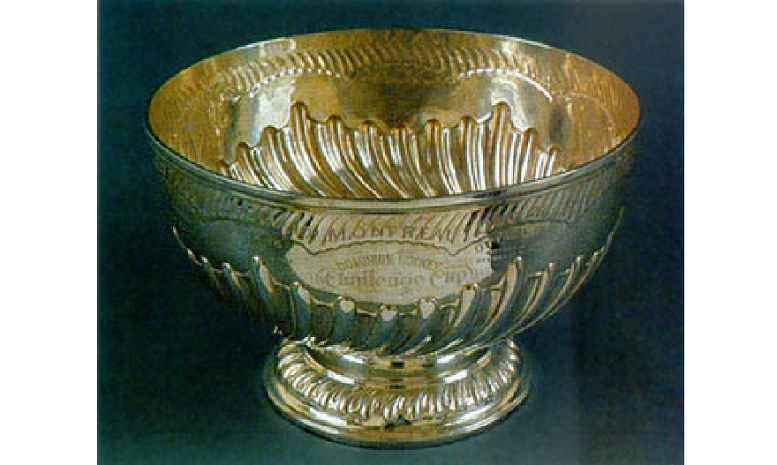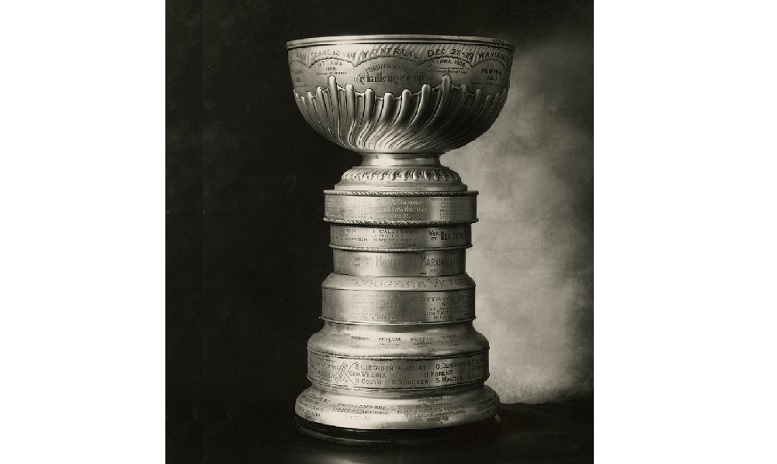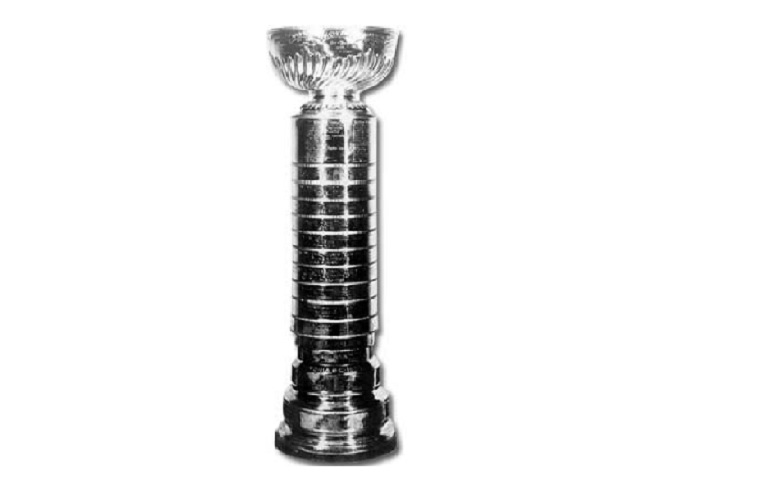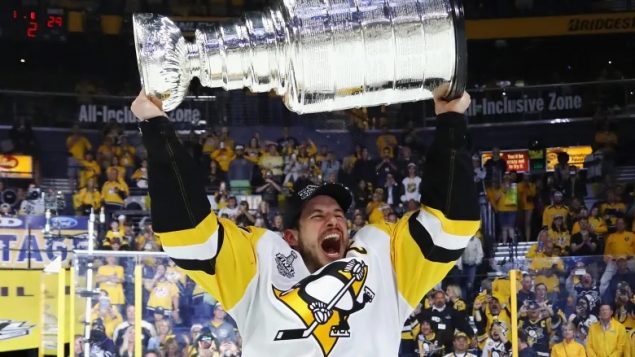In the late 1800’s ice hockey was gaining in popularity thoughout North America, especially in Canada, as well as in some northern U.S cities, where it had been introduced as much by Canadian students studying at U.S. universities as any other sources.
It was on March 18, 1892, that the idea that various Canadian teams should compete for a single trophy and under relatively uniform rules, there still being no codified national rule book.

The original Stanley Cup (Hockey Hall of Fame)
Lord Stanley of Preston, Canada’s Governor-General at the time proposed the idea and had the trophy cup purchased at a silversmith’s in London, England for ten guineas (very roughly worth about C$1500 today)
Letter from Lord Stanley
I have for some time just been thinking that it would be a good thing if there were a challenge cup which should be held from year to year by the champion hockey team in the Dominion.There does not appear to be any such outward and visible sign of championship at present, and considering the general interest which the matches now elicit, and the importance of having the game played fairly and under rules generally recognized,
I am willing to give a cup which shall be held from year to year by the winning team.I am not quite certain that the present regulations governing the arrangement of matches are entirely of satisfaction, and it would be worth considering whether they could not be arranged so that each team would play once at home and once at the place where their opponents hail
Stanley of Preston”
It was originally known as the Dominion Hockey Challenge Cup, with the rules for teams vying for the cup changing. Originally a trophy for amateur clubs, in 1910 it became a trophy for professional teams. In 1915, only the winners of the then two professional leagues, the National Hockey Association and the Pacific Coast Hockey Association decided that their two winning teams would contest for the “national” trophy.

The Stanley Cup circa 1930 with additional bands added as teams won the trophy over the years. (Library and Archive Quebec P1000,D1132)
It became an “international” professional trophy when an American team, joined the the Pacific league in 1914, A new league, the Western Canada Hockey league joined the trophy contest making it a three-way affair from 1922-25 when the Pacific and western leagues merged. In 1926, the single National Hockey League (formed in 1917) obtained exclusive control of the Stanley Cup and added three more American teams to the league.
Over the decades as the cup has been won by various teams and had members names engraved, the cup design has also been changed. This was a question of space. Getting out of hand in terms of size, bands are now retired to the Hockey Hall of Fame as they are superceeded by newer winners.
The cup now revered by hockey players and fans, was not always shown that level of respect.
In 1905 members of the winning Ottawa Silver Seven, who had been out celebrating their victory decided it would be a good idea to test its qualities as a football and it was subsequently booted off a bridge onto Ottawa’s frozen (Rideau) canal where it remained all night, It was only the next day when sober heads prevailed that someone went to see if it was still there, Luckily it was.
In 1907, the celebrating Montreal Wanderers forgot the cup at a photographers house where they had gone to get photos documenting their victory. The happily left the house but forget to take the cup with them. The photographer’s mother ended up using it as a flower pot for a few months until someone remembered where they might have left it.
In 1924, the Montreal Canadiens, on their way to a victory party, accidently left it in a snow bank for a few hours after they had to change a flat tire on their car.
In 1962, the cup was in a display case at the Chicago Stadium during the playoffs. A Montreal fan quietly took the cup from its display case and almost made it out before being stopped, Asked where he was going with it, he replied, “ I wanted to take it to Montreal..where it belongs”.
That year the original bowl and collar were put in the hockey hall of fame and replaced, but in 1970 the collar was stolen. It was found seven years later due to an anonymous tip to police who found it in the back room of a Toronto cleaning store.
Another theft attempt in 1977 was thwarted by keen eyed Hall of Fame staff who approached some suspiciously acting individuals carrying a large gym bag near the display of the cup. They ran off but police got them and found floor plans of the Hall of Fame and some equipment that could be used to steal the trophy. It turned out they were Universite de Montreal students involved in a scavenger hunt. They weren’t charged.

The Stanley cup from 1927 to 1947. By that year it was obviously getting unwieldy and it was decided to remove bands to a limited number and then as space ran out, replace a band with with a new one with the “retired band” going to the hockey Hall of Fame. (Hockey Hall of Fame)
The last “theft” was a prank by Montreal star forward Guy Lafleur in 1979 who quietly put the cup in his car after a victory parade in the city. He then drove to his home town of Thurso where he put the cup on display outside for family, friends, and residents of Thurso, Quebec. He returned it the next day to frantic officials who had been madly searching for it. He was not punished but very firmly told not to do that again.
In 1996, Colorado Avalanche defenceman Sylvain Lefevre christened his child in the cup.
Over the years there have been many players whose names have been misspelled, only a limited few have had their names corrected.
The Stanley Cup meanwhile has been taken by various winners and winning teams to Canada’s Parliament, the White House, and the Kremlin and toured at least 24 countries, including a trip to the Canadian Forces base in Kandahar during the war in Arghanistan
Additional information-sources







For reasons beyond our control, and for an undetermined period of time, our comment section is now closed. However, our social networks remain open to your contributions.